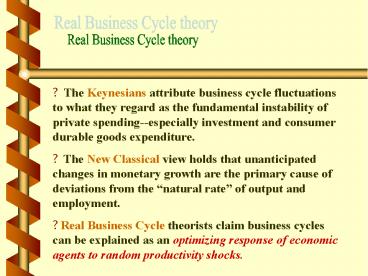Real Business Cycle theory - PowerPoint PPT Presentation
Title:
Real Business Cycle theory
Description:
Maximize consumption and leisure subject to constraints. ... is the time preference parameter, where 0 1; and. t is the LaGrangean multiplier in time t. ... – PowerPoint PPT presentation
Number of Views:927
Avg rating:3.0/5.0
Title: Real Business Cycle theory
1
Real Business Cycle theory
- The Keynesians attribute business cycle
fluctuations to what they regard as the
fundamental instability of private
spending--especially investment and consumer
durable goods expenditure. - The New Classical view holds that unanticipated
changes in monetary growth are the primary cause
of deviations from the natural rate of output
and employment. - Real Business Cycle theorists claim business
cycles can be explained as an optimizing response
of economic agents to random productivity shocks.
2
This is a tough model to explain to
non-economists
Optimizing agents
- Households
- Maximize consumption and leisure subject to
constraints. - Constraints include the number of hours in a day
and the resource prices (such as the wage).
- Firms
- Maximize profits subject to constraints
- Constraints include prices of outputs and inputs,
and productivity.
3
Constrained optimization problem for an
infinitely-lived representative
consumer-producer.
Charles Plosser. Understanding Real Business
Cycles, Journal of Economic Perspectives, Summer
1989, pp. 51-73.
If ?t increases, thatmeans you can getmore
output fromthe same stockof capital and work
effort
WhereL is the LaGrangean functionCt is
consumption in period tNt is work in period t1-
Nt is leisure in period tKt is the capital stock
in period t? is the depreciation rate per
period?t is a shift factor that alters total
factor productivity in period t. ? is the time
preference parameter, where 0lt ? lt 1 and?t is
the LaGrangean multiplier in time t.
4
When productivity rises,the opportunity cost of
leisure (measured in forgoneoutput) rises,
which induces therepresentative agent to
substitute work for leisure.Hence the random
productivity shock brings aboutan expansion of
real output.
The intertemporal substitution of work for
leisure (and vice versa) in reaction to
technology shocks is the principal force
underlying business cycle expansions and
contractions
5
The problem for Plosser, Finn Kydland, and other
Real Business Cycle theorists is to provide
plausible estimates of ?t or total factor
productivity.
The methods used to perform theseestimates have
been widely criticized
Annual productivity growth
6
4
2
Percentage rate of change
0
-2
-4
-6
1955
1965
1970
1975
1960
1980
1985
6
Policy implications of Real Business Cycle theory
- Some economists take the theory to mean that
countercyclical aggregate demand management is
doomed to ineffectiveness--since, after all, they
claim that 70 percent of the deviation of real
output from trend in the postwar era is explained
by productivity shifts. - Technological change is a factor that policy
makers cannot control. - Chatterjee explains that the Central Bank (the
FED in the U.S.) should nevertheless exercise
its stabilizing function in financial markets.

